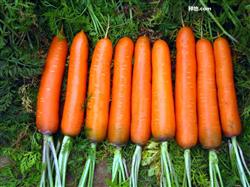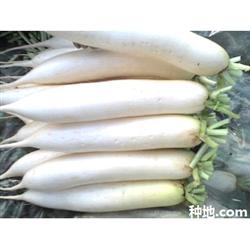How to grow out-of-season radish?

How do you grow anti-seasonal carrots? Please introduce anti-season radish, mainly compared with autumn winter storage radish, that is, white radish cultivated in spring and summer. White radish is beautiful in appearance, crisp and sweet in taste, fresh and juicy. It is a kind of vegetable that people like to eat. It is also one of the main varieties of export and deep-processed vegetables. Because it is cultivated in anti-season, it has large market development space, high price and good economic benefit. The technical points of anti-season cultivation of summer white radish are introduced as follows. 1. Variety Selection Summer cultivation should select heat-resistant, disease-resistant and high-yield varieties, such as Xia Zaosheng No.3, Xia Qiu Meinong, Bai Qiu Meinong, Baiyu Wang, etc. These varieties have beautiful appearance, pure white skin, smooth skin, few fibrous roots, straight roots, length of 35~40 cm, fleshy root diameter of about 6~6.5 cm, single plant weight of more than 1 kg, strong resistance to soft rot and black rot, good taste and high yield. In addition, the color of root bark of Dafu collar is half white and half green, the diameter of fleshy root is about 8.5 cm, the weight of single plant can reach more than 0.9 kg, and the disease resistance is better. Second, the main cultivation season and sowing time summer cultivation from the end of June to early July sowing, late August to early September harvest. Third, soil preparation, fertilization, sowing Because the white radish fleshy roots are long, it needs a deeper ploughing layer (more than 30 cm), and the soil should be loose and fertile sandy loam. Before sowing, soil preparation should be fully prepared, loose soil, levelled, and stones, rubble and hard objects in the soil should be removed. 2000kg of high-quality decomposed organic fertilizer, 20kg of diammonium phosphate and 3~ 4kg of potassium fertilizer are applied per mu. According to the row spacing of 50 cm, small ridges of 15 cm high are formed, furrows are formed in the middle of the small ridges, dark water hole sowing or dark water drilling is carried out, and the sowing quantity is 2~4 seeds/hole. Spacing between seedlings is 25~ 30cm. Fourth, field management summer cultivation to heat resistance, drought resistance, flood prevention, pest control. Cultivation plots must be easy to choose irrigation, loose soil, fertile sandy loam plots. Soil preparation, fertilization, seeding method and seeding amount, drainage ditch should be set in the field to facilitate timely drainage in rainy days. (1) Avoid rainy days when sowing. (2)In high temperature and dry weather, sufficient water should be ensured. After seedling emergence, small water should be poured frequently in the morning and evening, and well water should be poured to reduce the ground temperature, so as to improve the field microclimate and keep the soil moist. (3)Open the ridge in rainy days to prevent ponding and root rot. After heavy rain, water should be poured to increase the oxygen content of the soil and promote the normal growth of roots. (4) Thinning seedlings in time and intertillage to control weeds. (5)When the fleshy root begins to expand, appropriate nitrogen and potassium fertilizers should be applied. Ensure adequate and uniform water and fertilizer supply. 5. Pest control Summer cultivation in addition to the control of aphids, leaf miner, but also to control cabbage insects, moths and other pests, can be used Baicao No. 1, Baichongjing or 48% of Lesben for control. The main diseases were soft rot, black rot and virus diseases. The control methods were as follows: ① Strengthen field management, water and fertilize rationally, control aphids and weeds. Base fertilizer should be applied with enough decomposed high-quality organic fertilizer, pay attention to the application of phosphorus fertilizer and potassium fertilizer, and nitrogen fertilizer should be appropriate and not excessive.② Discovered diseased plants should be removed in time and disinfected in situ with quicklime to prevent infection from expanding. For controlling soft rot, agricultural antibiotic 751 can be used to dress seeds according to 1%~1.5% of seed weight, or Fengling 50g/mu can be used to dress seeds, or Fengling 50g can be used to treat water 50 liters, and ditches can be dug along the roots of vegetables to irrigate or spray. At the beginning of the disease, 72% streptomycin sulfate was used in 3000~4000 times solution. Black rot can be treated with thiram powder or 35% metalaxyl, or with thiram soil. In the early stage of disease, 72% agricultural streptomycin 3000~4000 times solution or Fengling 200 times solution can be sprayed once every 7~10 days for 3~4 times continuously. Click for more radish growing techniques Click for more vegetable growing techniques
- Prev

How to soak the seeds of carrots?
How to soak the seeds of carrots? Please guide carrot seeds because the epidermis is attached to a layer of bristles, so sow according to the conventional method, the emergence is slow and irregular. After years of practice, the effect of soaking seeds with hydrogen peroxide solution is better, and it has been popularized and applied in the carrot production base of Xiangcheng County. The time of soaking the seeds will be 2.
- Next

How does growing white radish increase yield?
How does growing white radish increase yield? Please guide white radish digging heart can increase production 40 to 50 days before the normal harvest of white radish, that is, when white radish grows to 0.25 to 0.5 kg, choose sunny days, use a knife, insert the tip of the knife into the center of radish heart leaf, dig out the growth point, if the heart leaf is not scattered, it proves that it has been dug out.
Related
- Where is it suitable to grow horseradish in China? it is expected to see the middle altitude horseradish in Alishan.
- How to prevent tomato virus disease reasonably? (Control methods included)
- Many people like to plant towel gourd on the balcony. What are the main points of this method and management?
- What crops can chili peppers be mixed with?
- Fertilization techniques and matters needing attention in Tomato
- What are the grafting techniques for peach seedlings in spring?
- Harm and control methods of root swelling disease of Chinese cabbage
- What are the pests of sweet potatoes? How to prevent and cure it?
- Symptoms, causes and Control methods of navel Rot in Tomato
- The cause of "Cucumber rotten bibcock" in Farmers' planting Cucumber and its Control Plan

